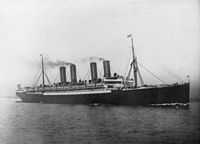The Battle of Río de Oro was a single-ship action fought in August 1914 during the First World War. The British protected cruiser HMS Highflyer attacked the German auxiliary cruiser SS Kaiser Wilhelm der Grosse off the small Spanish Saharan territory of Río de Oro.
Background[]
Under the command of Max Reymann, the German ship SS Kaiser Wilhelm der Grosse was originally a passenger liner, built in 1897, part of the German merchant fleet until requisitioned for service at the outbreak of World War I and fitted with six 4-inch guns and two 37-millimeter guns.
The German vessel set steam for a commerce raiding mission in the Atlantic Ocean. Commanded by Henry T. Buller, the British ship HMS Highflyer was a protected cruiser built in 1898 with eleven 6-inch guns, nine 12-pounder guns, six 3-pounder guns and two torpedo tubes. She had been detached to support the 5th Cruiser Squadron in hunting the German raider.
Battle[]
The battle off Rio de Oro on 26 August 1914 began when the German raider Kaiser Wilhelm der Grosse was caught by surprise in a harbor, taking on coal from three German and Austrian colliers. Highflyer, badly outgunning the German auxiliary cruiser, first demanded surrender, but the German commander argued that the British had violated Spain's neutrality.

Highflyer
The British disregarded this because the Germans had already violated Spain's neutrality by taking over a week to resupply in a neutral port. So a battle began, from 15:10 to 16:45 the two ships bombarded each other, sometimes dodging the shots. Eventually, Kaiser Wilhelm der Grosse exhausted her ammunition and began to flee the battle. Now out of ammunition, running from several larger guns, the crew scuttled their ship and abandoned her to the Atlantic.
The German sailors made it to shore and escaped into the Saharan Desert.
Aftermath[]
British sources at the time insisted the German auxiliary cruiser was sunk by Highflyer's crew but eventually stories from the surviving German seamen began to circulate, thus ending Britain's claim. Despite whether or not the Germans scuttled their ship or whether the British sank the raider, the British were still responsible for the raider's end.

Kaiser Wilhelm der Grosse
Kaiser Wilhelm der Grosse became the first passenger liner to sink during World War I. For years, the wreck of the German commerce raider was identifiable because its starboard side remained above the waterline until the ship was scrapped in 1952. One Briton was killed and six others wounded. German casualties are unknown.
See also[]
- Battle of Trindade
- SS Kronprinz Wilhelm - sister ship of Kaiser Wilhelm der Grosse
References[]
Further reading[]
- Colledge, J. J.; Warlow, Ben (2006) [1969]. Ships of the Royal Navy: The Complete Record of all Fighting Ships of the Royal Navy (Rev. ed.). London: Chatham Publishing. ISBN 978-1-86176-281-8. OCLC 67375475.
- Jane's Fighting Ships of World War One (1919), Jane's Publishing Company
External links[]
- The Great Ocean Liners: Kaiser Wilhelm der Grosse
- Lostliners: Kaiser Wilhelm der Grosse
- Maritimequest Kaiser Wilhelm der Grosse photo gallery
- Highflyer class in World War I
- History of HMS Highflyer
- HMS Highflyer
The original article can be found at Sinking of SS Kaiser Wilhelm der Grosse and the edit history here.
